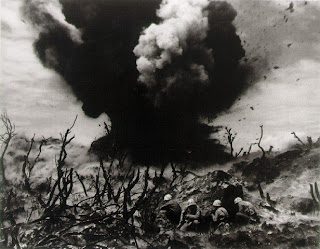Wednesday, September 25, 2013
Avoiding Mergers
Framing
This meets the rule of Framing because the bottom of the bridge creates a frame around the center of the photo which is all the buildings.
Balance
this photo show us balance because it captures the color, the way the building is falling to the left with the tree it make a triangle shape.
Lines
This is a good example of line because the lines allow the eyes to follow a path to the main subject.
The Rule of Thirds
This is a good example because if when you break up the photo into 3 imaginary rows and 3 imaginary columns the blue helmet is right on the bottom left intersection where the imaginary line would meet.
Simplicity
This is a good example of simplicity because it allows the eye to give the building the most visual attention. and the background is not a distraction.
Thursday, September 19, 2013
Great Black And White Photographs Part 2
Ansel Adams was born February 20th, 1902, in San Francisco, California. He died in Monterey, California on April 22, 1984. The Cause of his death was having a Heart Attack.
When Adams was a young child he was encountered in the 1906 San Francisco earthquake. He broke his nose and remained crooked for the rest of his life. He was hyperactive and had very little friends. His behavior was so bad he had to be dismissed from several schools. At the age of 12 he was educated by family members and private tutors. Adams became very passionate about the piano: he taught himself how to play. 1916 was the year Adams started to experiment photography. He married in 1928 to Virginia Best, and in 1935 she inherited the studio from her dad and from then on they continued the studio now known as Ansel Adams Gallery.
Adams first portfolio was " Parmelian Prints of the High Sierras", which includes his famous photo "Monolith, the Face of Half Dome." 1929 through 1942 his work developed and he spent time in New Mexico and began to publish essays and instructional books on photography. Adams joined photographers Dorothea Lange And Walker Evans in attempts to affect social and political change through art.
by the 1960's and 1970's Adams spent time printing negatives to finish his iconic work. and in 1974 the Mertopolitan Museum of Art hosted a Retrospective exhibit where Adams photos were shown.
Red, Metal, Happy
Red
This Picture stands for red. I like this picture because the angle that the photo is taken shows an awesome background and the red really pops out.
Metal
This picture is representing metal. I liked this picture because the metal blocks everything out and the brightness is the background brings the metal to life.
Happy
I took this picture to stand for happy. I choose this picture because it has a rainbow and rainbows seem to bring happiness to the world and its a representation of joy.
National Geographic Warm-Up Favorite Photo
This is one of my favorite photos because on the left hand side you see the world moving in a fast pace and it looks awesome to see how fast things go by. On the Right hand side you see things a little slower. The way the opposite views are brought together makes the photo so fascinating.
Wednesday, September 11, 2013
Camera Parts
Aperture- an opening or hole
Shutter- a device that opens and close to expose film in a camera
Exposure- measuring and balance of light
Depth of Field- the distance between the nearest and furthest objects that give an image judged to be focus in a camera.
F-stop - a camera setting corresponding to a particular f - number.
Focal Length- the distance between the center of the lens or curved mirror and its focus
Top view
1. model dial - changes the cameras mode
2- power switch - it turns the camera on and off
4. main dial - to change focus points, make exposure compensation adjustments
10. Lens mount - used to connect components
16. hot shoe - is a mounting point and attaches a flash unit
Camera History
The Camera
2. In the 17th century, the understanding of optics and the process of making high quality glass lens helped man to get a step closer to making a modern camera.
3. The parts of the first modern camera invented by Niepce were a glass lens, a dark box, and film
4. It has the lens, dark box, and film. its the same as Niepce camera.
5. Digital cameras capture images with an electronic sensor call CCD.
Camera Modes
6. The Auto mode will completely control flash and exposure. The program mode, you are able to control flash and other camera settings.
7. The portrait mode is used to blur out the background and uses the fastest available lens.
8. The sports mode is used to freeze motion, camera will use the highest shutter speed possible.
The Half Press
9. You should do a half press on the trigger button because it creates a focus lock meaning it will freeze the point of focus before taking the photograph. Also, the camera responds quicker.
Controlling Flash
10. Its called the Disabled Flash, it means there is no flash. its used when the natural light is used.
11. Its called the Auto flash. it automatically flashes if it think it needs more light.
11. Its called the Auto flash. it automatically flashes if it think it needs more light.
Introduction to Exposure
12. If your photo has to much light it will be washed out.
13. If your photo doesn't have enough light it will be too dark.
The Universal Stop
14. Stop represents a relative change in the brightness of light
15. If the planet had 2 suns it would have a stops brighter of 1.
16. If the planet had 4 suns it would have a stops brighter of 2.
Shutters and Aperture
17. long shutter speed equals more light
18. short shutter speed equals less light
19. The Aperture controls how much light passes through.
20. You increase the amount of light by having larger F-stops.
Thursday, September 5, 2013
First Photo's Best And Worst
This is my worst photo because its super blurry and it doesn't look nice. I chose this one because i didn't like it. It doesn't have an eye catcher and it just looks a mess. This is the worst because it makes it hard to concentrate.
This is my best photo because the picture is clear and he has a good smile on his face. I chose this one because its clear and its nice. what I did to make this photo look nice was take my time taking the photo and making sure I wasn't shaking.
Tuesday, September 3, 2013
Subscribe to:
Posts (Atom)



















